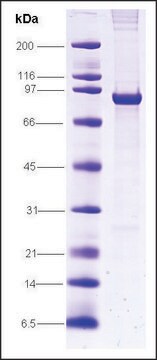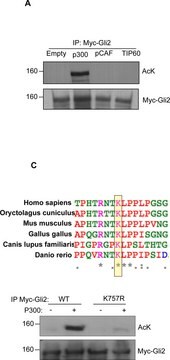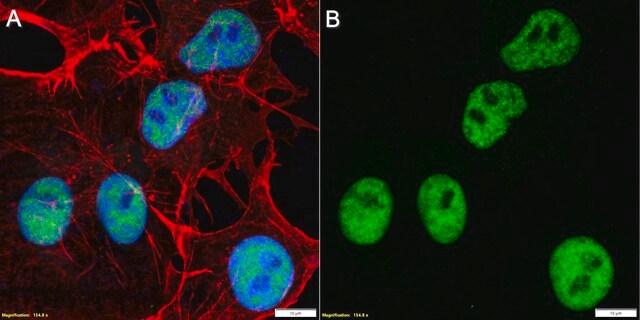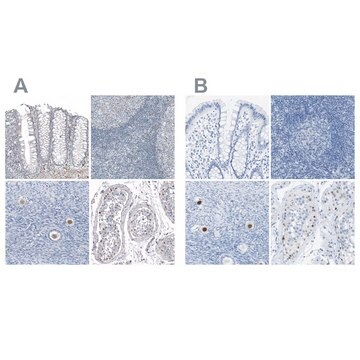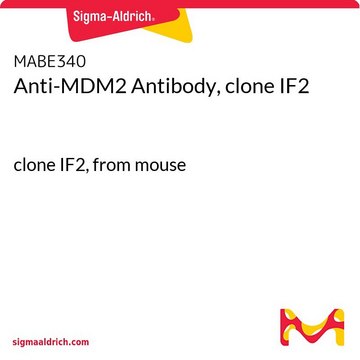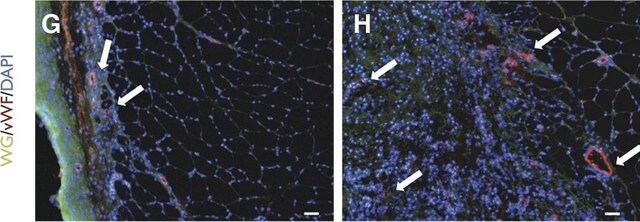추천 제품
일반 설명
Both the Simian virus (SV40) large T and small T antigens are encoded by the early region of the SV40 genome. The large T antigen binds DNA, and complexes with a 53,000 dalton cellular protein, p53, which is required for initiation of viral DNA replication during lytic growth. In addition the large T antigen binds DNA polymerase and the transcription factor AP-2 and forms a specific complex with the P105 product of the retinoblastoma susceptibility gene.
특이성
This antibody recognizes the large T antigen of SV40.
면역원
Epitope: Large T antigen of SV40
Purified large T-antigen of SV40
애플리케이션
Anti-SV40 Large T Antigen Antibody, clone PAb416 is an antibody against SV40 Large T Antigen for use in Western Blotting, ICC.
Immunocytochemistry Analysis: A representative lot from an independent laboratory detected SV40 Large T Antigen in ICC (Sabatier, J., et al. (2005). 58(4):429-431.; Del Valle, L., et al. (2004). J Virol. 78(7):3462-3469.).
Research Category
Inflammation & Immunology
Inflammation & Immunology
Research Sub Category
Immunoglobulins & Immunology
Immunoglobulins & Immunology
품질
Evaluated by Western Blot in Cos-1 cell lysate.
Western Blot Analysis: 1 µg/mL of this antibody detected SV40 Large T Antigen in 10 µg of Cos-1 cell lysate.
Western Blot Analysis: 1 µg/mL of this antibody detected SV40 Large T Antigen in 10 µg of Cos-1 cell lysate.
표적 설명
~82 kDa observed
물리적 형태
Format: Purified
Protein G Purified
Purified mouse monoclonal IgG2aκ in buffer containing 0.1 M Tris-Glycine (pH 7.4), 150 mM NaCl with 0.05% sodium azide.
저장 및 안정성
Stable for 1 year at 2-8°C from date of receipt.
분석 메모
Control
Cos-1 cell lysate
Cos-1 cell lysate
기타 정보
Concentration: Please refer to the Certificate of Analysis for the lot-specific concentration.
면책조항
Unless otherwise stated in our catalog or other company documentation accompanying the product(s), our products are intended for research use only and are not to be used for any other purpose, which includes but is not limited to, unauthorized commercial uses, in vitro diagnostic uses, ex vivo or in vivo therapeutic uses or any type of consumption or application to humans or animals.
적합한 제품을 찾을 수 없으신가요?
당사의 제품 선택기 도구.을(를) 시도해 보세요.
Storage Class Code
12 - Non Combustible Liquids
WGK
WGK 1
Flash Point (°F)
Not applicable
Flash Point (°C)
Not applicable
시험 성적서(COA)
제품의 로트/배치 번호를 입력하여 시험 성적서(COA)을 검색하십시오. 로트 및 배치 번호는 제품 라벨에 있는 ‘로트’ 또는 ‘배치’라는 용어 뒤에서 찾을 수 있습니다.
Immunodetection of SV40 large T antigen in human central nervous system tumours.
Sabatier, J, et al.
Journal of Clinical Pathology, 58, 429-431 (2005)
Primary central nervous system lymphoma expressing the human neurotropic polyomavirus, JC virus, genome.
Del Valle, Luis, et al.
Journal of virology, 78, 3462-3469 (2004)
Yasuko Orba et al.
The Journal of general virology, 92(Pt 4), 789-795 (2010-12-24)
To investigate polyomavirus infection in wild rodents, we analysed DNA samples from the spleens of 100 wild rodents from Zambia using a broad-spectrum PCR-based assay. A previously unknown polyomavirus genome was identified in a sample from a multimammate mouse (Mastomys
Ursula Neu et al.
PLoS pathogens, 9(10), e1003688-e1003688 (2013-10-17)
Viruses within a family often vary in their cellular tropism and pathogenicity. In many cases, these variations are due to viruses switching their specificity from one cell surface receptor to another. The structural requirements that underlie such receptor switching are
Furong Yuan et al.
Oncology reports, 23(2), 377-386 (2010-01-01)
Werner syndrome (WS) results from defects in the gene encoding WRN RecQ helicase. WS fibroblasts undergo premature senescence in culture. Because cellular senescence is a tumor suppressor mechanism, we examined whether WS fibroblasts exhibited reduced tumorigenicity, in comparison to control
자사의 과학자팀은 생명 과학, 재료 과학, 화학 합성, 크로마토그래피, 분석 및 기타 많은 영역을 포함한 모든 과학 분야에 경험이 있습니다..
고객지원팀으로 연락바랍니다.